


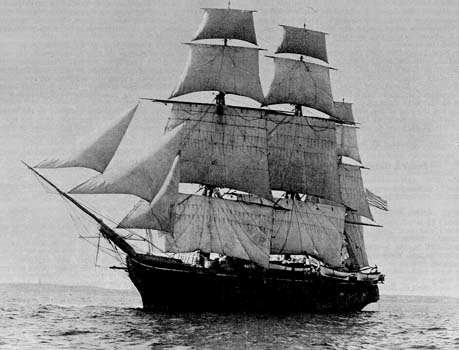
USS JAMESTOWN 1
SLOOP OF WAR
The first Jamestown was a sloop of war launched in 1844 by the
Navy Yard, Gosport, VA. Leaving Hampton Roads on June 25, 1845, she
was the flagship of Commodore Charles W Skinner. Commodore Skinner
was in command of the U.S. naval vessels operating off the western
coast of Africa to suppress the slave trade. The sloop returned to the
U.S. and ported in Boston on August 6, 1846. While moored in Boston,
word reached the States about the second consecutive year that blight
had ruined the potato crop in Ireland. The Jamestown and the
Macedonian were used to carry food to Ireland in March 1847.
Next she served as the flagship of Commodore W. C. Bolton
again operating off the west coast of Africa. In 1848 she was
transferred to the Mediterranean Squadron to help protect Americans
during the epidemic of revolutions which convulsed Europe. In 1851
she was assigned to the Brazil Squadron and returned to Philadelphia
in May of 1854. Then for the third time the Jamestown sailed as
the flagship of the African Squadron in 1855 to 1857.
With the outbreak of the Civil War the Jamestown became part
of the Atlantic Blockading Squadron. While with the squadron she
compiled a record of outstanding efficiency. In October 1862, the
Jamestown set out for the Pacific where she protected American
commerce from Confederate Privateers, until September 1865. After
the war ended she served as a stores and hospital ship in Panama
until a fever broke out on board. On April 2, 1867, she was ordered
north to help relieve the fever and to join the North Pacific
Squadron. While the ship was part of this unit she hoisted the
U.S. flag over Sitka, Alaska on October 18, 1867, Alaska had
just been purchased from Russia.
For the next three years the Jamestown cruised the Pacific from the west coasts of North and South America. She also sailed as far west as Tahiti, Fiji and the Hawaiian Islands. In February, 1882, she was refitted as an apprentice training ship and proceeded to the Atlantic coast via Cape Horn. She sailed the Atlantic Ocean until September, 1892, when the ship was transferred to the Treasury Department. The Jamestown served as a marine hospital ship for quarantine purposes in the Hampton Roads harbor. A fire destroyed her on January 3, 1913 after being returned to the Navy Department.


CSS JAMESTOWN
CONVERTED PASSENGER STEAMER
Jamestown 2, originally a passenger steamer, was built
at New York NY in 1853 and was seized at Richmond, VA in 1861 for the
Commonwealth of Virginia Navy. She was commissioned by the Confederate
Navy the Following July, renamed Thomas Jefferson, but was still generally
referred to as Jamestown.
Brigantine-rigged, Jamestown was designed and constructed by
the well known William H. Webb for the New York and Old Dominion Line
as a sister to Yorktown(v. Patrick Henry).
With Lt J. N. Barney, CSN, in command she was actively employed
until the end of her career in May 1862. Her service was highlighted by
the Battle of Hampton Roads on 8-9 March 1862, during which she assisted
CSS Virginia in attacking the USS Congress and USS Cumberland and stood by
during the battle between the Monitor and Virginia (Merrimack), The
Confederate Congress tendered special thanks to the officers and crew
of Jamestown for their "gallant conduct and bearing" in combat.
Some four weeks later, on 11 April 1862, Jamestown, Virginia
and five other Confederate ships sailed from Norfolk into Hampton Roads
in full view of the Union squardron there. When it became clear that
the Federals were not going to attack, Jamestown, covered by Virginia
and the others, moved in, captured three merchant ships and helped by
CSS Raliegh towed them to Norfolk. Later that month Jamestown
was dispatched from Norfolk to cooperate with Major General Magruder
CSA, in the James River and early in May she was used to transport army
sick and wounded to Richmond.
On the night of 5 May, CSS Jamestown and CSS Patrick Henry
proceeded to Norfolk and returned the following night with
CSS Richmond, CSS Hampton, and ordnance store boats, passing the
Federal battery at Newport News; unobserved on both occasions.
A second attempt to return to Norfolk met failure.
On 8 May Jamestown was ordered to notify the Secretary
of the Confederate States Navy of the continuing engagement of two
Federal gunboats and Ironclad Galena, which retired up the James River
as far as Drewry's Bluff where on 15 May 1962 she was sunk to obstruct
the channel.


USS JAMESTOWN 3
PG-55/AGP-3
The third Jamestown was at first the largest and most
luxurious yacht in the world at that time. The Savarona was built
in 1928 in Wilmington, Delaware, for Mrs. Thomas S. Cadwallader of Philadelphia. The Navy obtained the yacht on December 6, 1940 and
converted her into a gunboat. She was commissioned the USS Jamestown
(PG-55) on May 26, 1941. The Jamestown's first summer was spent
training Naval Academy Midshipmen. At the end of the summer the
vessel was refitted as a motor-torpedo-boat tender. With the refit
complete she left for the South Pacific in June, 1942.
The Jamestown's first action in the Pacific was in the New
Caledonia battle. She fearlessly patrolled "Iron-Bottom Sound," and nightly challenged Japanese destroyers, cruisers, and even
battleships of "The Tokyo Express" here. By day she worked
feverishly to ready the battered and worn boats for their next
patrol. She served here until February, 1944, when she left for
the States for a well earned and badly needed overhaul. In
August, 1944, the repair work was finished and the Jamestown
was back in the fighting this time at New Guinea. On February
5, 1945, the Jamestown was ordered to the Philippines where she
performed convoy duty. The vessel set sail for the United States on
October 20, 1945 and arrived at San Francisco on November 24.
She was decommissioned there on March 6, 1946; ending her busy
and useful service.


USS JAMESTOWN 4
AG-166/AGTR-3
The fourth Jamestown was a converted Liberty ship, originally
launched as the J. Howland Gardner. The Navy obtained her on August
10, 1962, and commissioned her the USS Jamestown (AG-166) on
December 13, 1962, at the Norfolk Navy Yard. After being refit
she left Norfolk on January 20, 1964, for Guantanamo Bay, Cuba.
She was there when Cuba's Fidel Castro shut off all fresh water
to the base and stood by ready to evacuate American families if
it was necessity.
After returning to port, the Jamestown was redesignated as
AGTR-3 and sailed around Africa, then around the Caribbean until
July, 1964. Three months later the ship got under way for the Far
East and reached the Philippines on December 29, 1964.
In February 1966, Captain Henry J. Lyon assumed command of USS
Jamestown and served as her Commanding Officer until January
1967. Captain Lyon's ship was an unusual ship in that it had no guns to
speak of while serving in enemy waters most of the time. The Jamestown
was a technical research ship, with the assigned mission of conducting technical research projects. Some of these projects included
electromagnetic propagation studies and advanced communications such
as communications moon relay and satellite communications. While in
the Pacific Fleet, it helped meet the increased communications
requirements resulting from the build-up of U.S. Forces in Southeast
Asia. The Jamestown had been awarded the Battle Efficiency "E,"
which is annually awarded to the best ship in each class.
The Jamestown operated in the South China Sea gathering
valuable information for the Navy's ships fighting in South Vietnam.
She also added to the long naval tradition of serving the field of
scientific research. The ship continued operating in the Far East,
often in the Vietnam War Zone. After the end of the Vietnam War,
the Jamestown, having served the Navy well, was decommissioned.

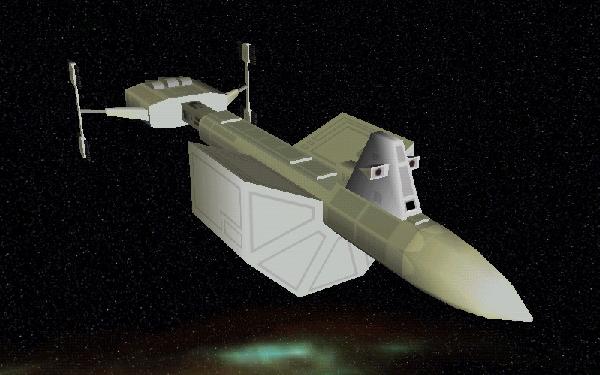
SS JAMESTOWN 5
DY-100 CLASS
The DY-100-class, an ancient type of interplanetary vehicle first built on Earth in the late 20th century, was the first mass-produced interplanetary ship. With its nuclear-powered engines for extended voyages, the DY-100 proved a most versatile carrier. Rigged for duration travel, it was the first manned ship to Mars. The S.S. Botany Bay, a DY-100-class vessel equipped with suspended animation facilities, was launched from Earth in 1996 with the dictator Khan Noonien Singh and his and his followers aboard.
The fifth Jamestown was launched on January 9, 2036 (one of the last of many vessels in this class), and commanded by United States Navy Captain Corey D. Thomas. This spacecraft was part of the first joint exploration mission between the United States and the European Space Agency to Mars. The craft arrived in orbit of Mars on September 29, 2036, with the first landing taking place on October 12th. After spending a month on Mars collecting valuable and priceless data, the SS Jamestown returned to Earth on July 20, 2037. The SS Jamestown also left 105 Colonists on Mars (One of which was a Julien Picard, a distant relative of Captain Jean-Luc Picard).

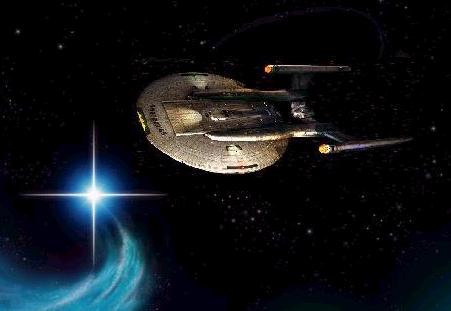
SS JAMESTOWN 6 (NX-05)
NX CLASS EXPLORER
The fifth NX Class vessel was the sixth ship to be named Jamestown, and was launched on Aug. 21, 2152. The USS Jamestown was powered by a second generation warp drive with a top speed of warp 5. She served Earth well by mapping a large part of what was to become Federation space and unknown space at that time. On October 30, 2155, while under the command of Captain Charles Ride, the 'Jimmy-T' was starmapping on the edge of known space in what would become the Romulan Neutral Zone when she disappeared. At that time, Starfleet did not have a clue about the cause of its disappearance, and no evidence of the Jamestown's fate was recovered. However, on stardate 48674.1 (2370), Starfleet discovered that NX-05 had been destroyed by the Romulans in a battle near the Klingon outpost of jacDlchHatlhyuQ (Planet of Six Countries) in some captured records.

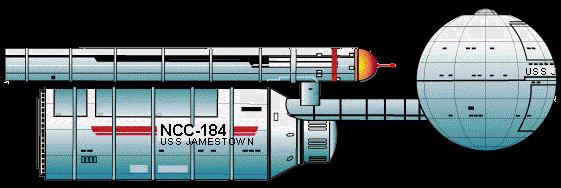
USS JAMESTOWN 7 (NCC-184)
DAEDELUS CLASS CRUISER
The next year the Earth declared war on the Romulan Star Empire, and with the outbreak of hostilities a new class of fighting ships was launched: the Daedalus Class Cruiser. One of these ships, the seventh Jamestown, was launched on March 15, 2159. She fought in many battles against the Romulans during the war and was a participant in the Battle of Cheron, the final battle of the war. In command was Captain James T. Glenn, who later was promoted to Rear Admiral and became Commandant of Starfleet Academy. After the war ended, the USS Jamestown continued to serve the fleet well until she was decommissioned on June 15, 2195.

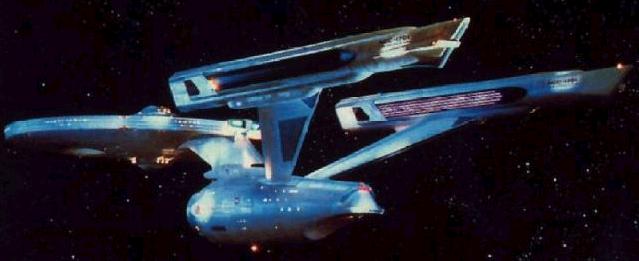
USS JAMESTOWN 8 (NCC-1843)
ENTERPRISE CLASS HEAVY CRUISER
Launched on stardate 8208 (September 8, 2272), the eighth
Jamestown (NCC-1843) started her service to the Federation. She was
constructed in Starfleet's Newport News Orbital Shipyard and
Spacedock. She was the third Enterprise Class Heavy Cruiser to be
built (not refitted). This class vessel has the advanced fourth
generation warp drive with a maximum speed of warp 12. The ship was commanded by Rear Admiral Stephen C. Thomas. While other
details about the ship and her missions are classified, it has been
stated by Starfleet that both the vessel and her crew performed
exemplary service to the fleet.
On stardate 9112.15 (2280), while approaching the Gamma
Cordinis star system, the ship was drawn into an unexpectedly
powerful gravitational field. It was reported later that it was
a black hole, which accelerated the ship past its normal warp limits.
In fact, the ship had been propelled through time to stardate
44323.54 (2365). After making contact with Starfleet, they were
directed to rendezvous with the science vessel USS Ochoa. After
arriving at Starbase 472, the ship was notified that it had been
officially declared "missing in action" nearly 80 years earlier on
stardate 9612 (2280).... and that three other "Jimmy T's" had
been launched and decommissioned or lost in their absence. Now, the
thirteenth ship to be named Jamestown was under construction.
Through public reaction to the ship's homecoming, it was decided
to give the new ship to the old crew. On stardate 44368.3 (2365)
Rear Admiral Thomas took command of the new ship in a transfer
ceremony at the Mars Orbital Dockyard. His old ship was claimed
by the Federation, acting on behalf of the Smithsonian Institution.
It was placed on exhibition at the Garber Station 6, a converted
dockyard facility orbiting Earth's moon. (More information about these
four ships follows.)

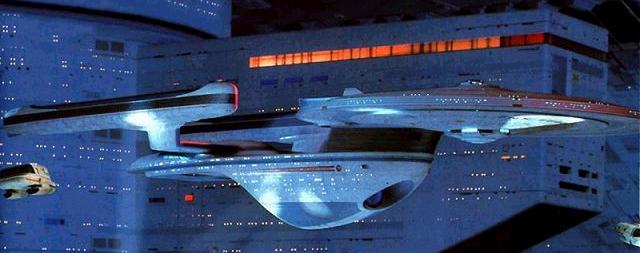
USS JAMESTOWN 9 (NCC-1843-A)
EXCELSIOR CLASS BATTLESHIP
The ninth ship to bear the name of Jamestown was
commissioned on stardate 9305 (2282). Starfleet, in the tradition
of the Enterprise, the ship was named USS Jamestown, NCC-1843-A.
It was the next to last ship to be built of the Excelsior Class
Battleships before Starfleet switched to the upgraded version used for the USS Enterprise-B. Some of the important campaigns and missions of the
ship was the safe penetration of the Galaxy Barrier and the Battle
of Rendar with the Romulans. Her last Commanding Officer was
Captain John Cantwell, who tood command on stardate 10436.3
(2293). (He was one of the young captains in Starfleet at that
time. Also, the son of one of the officers who was on the original
NCC-1843.) He lead the ship on a research mission to the
Gamma Coronis worm hole where his dad was lost. On stardate
10507.5 (2294) while on this mission, the ship was also lost in
the same worm hole. Starfleet expects this ship to reappear
on stardate 447526.4 (2407).


USS JAMESTOWN 10 (NCC-1843-B)
CONSTELLATION CLASS STAR CRUISER
Four years after the loss of Jamestown-A, Starfleet launched
the USS Jamestown, NCC-1843-B, a Constellation
Class Star Cruiser, commissioned on stardate 10936.5 (2298). One of
its important missions was the mapping of Sector 424. This mission
took 12 years and two captains to finish it. One being now
Commodore Matt Decker IV, the great-grandson of Commodore Matthew
Decker of the Doomsday Machine Incident. Another campaign was
the Battle of Klin 4, to be later identified as having been with
the Ferengi. While other parts of the ship's missions are
classified, it was stated by Starfleet that both the vessel and
her crew performed exemplary service to the Fleet. She was
decommissioned stardate 13957.5 (2328).


USS JAMESTOWN 11 (NCC-1843-C)
AMBASSADOR CLASS HEAVY CRUISER
The eleventh ship named Jamestown (NCC-1843-C) was an Ambassador
Class Cruiser, and was commissioned on stardate 14126.5 (2330). Some
of its most important missions were under the leadership of
Captain Jack Armstrong. The Jamestown discovered the giant twin
black holes which were named Alam'ak and Behr'ak near the Salayna
system. At the Second Battle of Khitomer under the command of Commodore James Carson, she was
the flagship of a combined Federation and Klingon fleet against a
Romulan fleet. After heavy loses on both sides, the Jamestown won
the battle by destroying the last Romulan battleship. At which time
the rest of their fleet left Khitmoer for home. After the battle,
the Jamestown continued to perform exemplary service to Starfleet
for many years. On stardate 40136.5 (2360) the 'Jimmy T' had just
started a five year mapping mission to the Orion Arm of the Milky Way
Galaxy. On stardate 41374.4 (2362) Starbase 156 received a strange
message from the Jamestown, which stated that they were under
attack, but the message ended abruptly. At once Starbase 156 sent
out a rescue ship, but it took two months at top warp speed to reach
the last known coordinates of the Jamestown. When the USS Achilles
arrived it found no sign of the ship or any disturbance in the area. Also
no shuttles or any survivors were found on any planets nearby.
(Later it was believed that the incursion was a Borg attack).

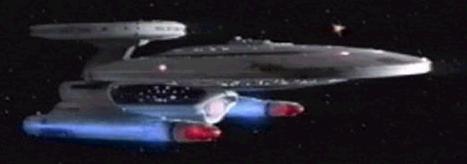
USS JAMESTOWN 12 (NCC-1843-D)
NEBULA CLASS LIGHT CRUISER
The twelfth and most recent ship to be named Jamestown (NCC-1843-D)
is a Nebula Class Light Cruiser. She was launched on stardate 44369.3 (2365)
with Rear Admiral Stephen Thomas in command. This
new Nebula Class ship is different from the seventh "Jimmy T", but in
many ways it is the same. Even though this new ship is a light cruiser,
it has as much more fire power and greater the old heavy cruiser.
Admiral Thomas and his crew had many adjustments to make while living in the 24th century, including having families aboard ship. Nonetheless, the crew soon found their niche and were able to perform admirably. Many of her missions were those of exploration near the galactic rim and also into the farther reaches of the Beta Quadrant. Eventually, the now Vice Admiral Thomas would pass command to Rear Admiral Richard Hewitt, and continue Starfleet's mission of exploration.
Most recently, under command of Commodore John Winsley, this Jamestown served with the Allied Seventh Fleet during the Dominion War, and was among the 14 of the original 112 ships to survive the conflict. After extensive repairs, the Jamestown has set out again, aiding in the cleanup of Bajoran and occupied Cardassian space interspersed with the occasional skirmish against rogue Breen elements.

USS JAMESTOWN 13 (NCC-1843-E)
VESTA CLASS STARSHIP
The end?

FOOTNOTES
1 Stardate is made up of four or five digits being the number
of days since the start of space travel on Earth.
2 Old Earth date.
3 It was discovered in the early 21st Century by the Compton Gamma
Ray Observatory which was launched by NASA in 1990.
4 Starfleet decided with the start of the 24th Century or 2300 old Earth
date that the stardate would start with the number 4 (for 24th Century)
followed by four or five digits for the number of days since the start of
the century.
5 Named for Ellen Ochoa, a NASA Astronaut in the 1990s.
6 Its function is simular to those of the old Earth Garber Facility
in Maryland, USA.

=/\=Home|Jamestown History|
